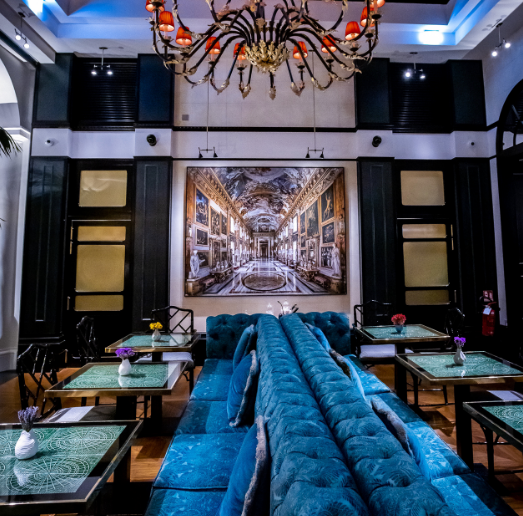 In the heart of Rome stands a prestigious building overlooking via delle Muratte, a long street that connects the Pantheon to the Parliament and the Trevi Fountain. Historically known as “The street of the artists”, the painters’ ateliers coexisted with antique stores and workshops from which have been produced creations of high-end craftsmanship.
In the heart of Rome stands a prestigious building overlooking via delle Muratte, a long street that connects the Pantheon to the Parliament and the Trevi Fountain. Historically known as “The street of the artists”, the painters’ ateliers coexisted with antique stores and workshops from which have been produced creations of high-end craftsmanship.
In this context full of history and suggestions, RPM Proget, the Roman Studio which boasts a consolidated know-how in the design and realization of spaces for the restaurant, hotel and retail sectors, has carried out an important project for a luxurious five-star hotel, the Maalot Hotel, which is now fully operational and has already been present in the hotel panorama in the centre of Rome for months, with very flattering returns.
The hotel is composed of four floors for a total of about 3.000 square meters in an elegant historic building of the nineteenth century where, between 1828 and 1837, the great composer from Bergamo Gaetano Donizetti, stayed.
A TABLE AT DON PASQUALE
Don Pasquale – one of the composer’s most successful works – is the name chosen for the gourmet restaurant, which is already one of the hotel’s excellence and a reference point for local restaurants.
In the kitchen, there is the young Chef Domenico Boschi who works on tradition and captures the most refined aspects of the local gastronomy with a menu offering traditional Roman cuisine (from the cacio e pepe to the amatriciana and carbonara) reinterpreted to be more consistent with the spirit of the restaurant, as well as the proposal of more exclusive dishes.
In addition to being located in a hotel, Don Pasquale is a restaurant with a strong personality and attracts a Roman and international clientele. This is reinforced by the restaurant’s strong external exposure and the presence of great and appealing dehors, as well as the central location near the Roman political buildings.
All the aspects that inspired the genesis of this important project converge ideally in the design of the Don Pasquale restaurant” says Roberto Antobenedetto, architect of RPM Proget.
The restaurant has about sixty seats. The choice of colours was orientated towards soft tones, with an emphasis on green and beige, while the floors are made of old oak parquet in a warm honey shade. The green colour is particularly relaxing and contrasts with the red glossy coverings and matte couches. A space that expresses the ‘green’ vision always present in the projects of RPM Proget and that has given birth to a singular and suggestive environment, in an atmosphere that combines historical charm and refinement.
The restaurant is a real lounge room in the middle of the alleys of the historical centre of Rome. Not without reason, the chairs are not the only protagonists but accompany the seats and sofas that create an atmosphere of a private residence.
The restaurant’s rooms are designed as a refined art gallery where popular artists feature the walls in a contemporary setting. Stanley Gonczansky, Gonzalo Fuenmayor and Massimo Listri exhibit their works as is customary in the street of the artists, where the Maalot Hotel is located.
The game of irreverent and ironic interpretations of Goncansky’s classic technique that can be read by approaching what seem to be “important” canvases is contrasted with Fuenmayor’s fascinating and solemn black and white and with the monumental architectural constructions of Nistri’s photography to populate refined spatial restlessness, which all want to be less than banal, and Don Pasquale is here to prove it.
The restaurant’s tables are made of embroidered Portuguese ceramics sheltered by the glass with golden reflections which, together with the rich set of mirrors, creates a scenic atmosphere of great expressive coherence.
The lighting revolves around a large chandelier, designed specifically for this project by the architect Antobenedetto. With a large circumference and height of one meter eighty, the chandelier emanates a soft light regulated by a dimmer that creates a warm and relaxing atmosphere. A play of perspectives and intriguing details such as bar cartwheels, fill the lounge space creating an original visual journey.
The reception has also been designed as a lounge, with fireplaces, armchairs and sofas, an elegant office composed of a rich selection of books at the disposal of guests. In this way, the reception becomes a relaxing area where check-in and check-out turn into a pleasant moment, through a more informal process, as well as a moment of greeting, accompanied by a glass of bubbles.
A CHARMFUL RESIDENCE
The style of the Maalot Hotel recalls the atmosphere of English homes, from the fabric walls to the fitted carpets, furniture and lights, to the colours of the thirty rooms, all different, decorated with fabrics, pillows, curtains and fitted coverings in soft colours that blend harmoniously.
The acoustics were addressed structurally both in the floors and walls with the application of gypsum fibre and Silent Diamond panels. The idea of dressing the rooms “in fabric” helps to reduce noise, as fitted carpets and padded fabric coverings create a muffling effect that enhances soundproofing.
The thirty rooms are categorized according to their usable area, from the traditional 16 square meter master bedroom, the rooms of 25-27 square meters, to the rooms with living room and larger spaces such as mini-apartments with living room, library and stone scenic fireplace. All rooms have a custom dressing room made of Daniela walnut wood with a space dedicated to the hanging rail and shoe rack and another space dedicated to the dresser, which includes the fridge and built-in safe shelf.
The bathroom is covered with Calacatta arabesque marble a macchia aperta, as is the top of the integrated sinks. Again, the goal was to create a distinct space for the bathrooms.
The two rooms in the attic have Portoro marble’s black background with gold vein, a refined and atmospheric covering. Inside the bathrooms of these small suites, the Daniela walnut wood was also used and matches well with the black and gold background of the Portoro marble.
Removing these aspects emphasize the fact that we are in a boutique hotel where furniture and accessories are a unicum in all rooms. A two-tiered mirror with the central area recessed creates a play of depth and is a specific feature, born from observing a mirror exhibited in an antics market in Florence.
The paintings inside the rooms are inspired by the song of Marvin Gaye: ‘Wherever I lay my hat, that’s my home. The hat becomes the protagonist of the graphic illustration of the rooms and creates a voluptuous and coherent story that continues in the common areas.
Edited by: Matthew Thomas
Maalot Hotel And Don Pasquale Restaurant




















